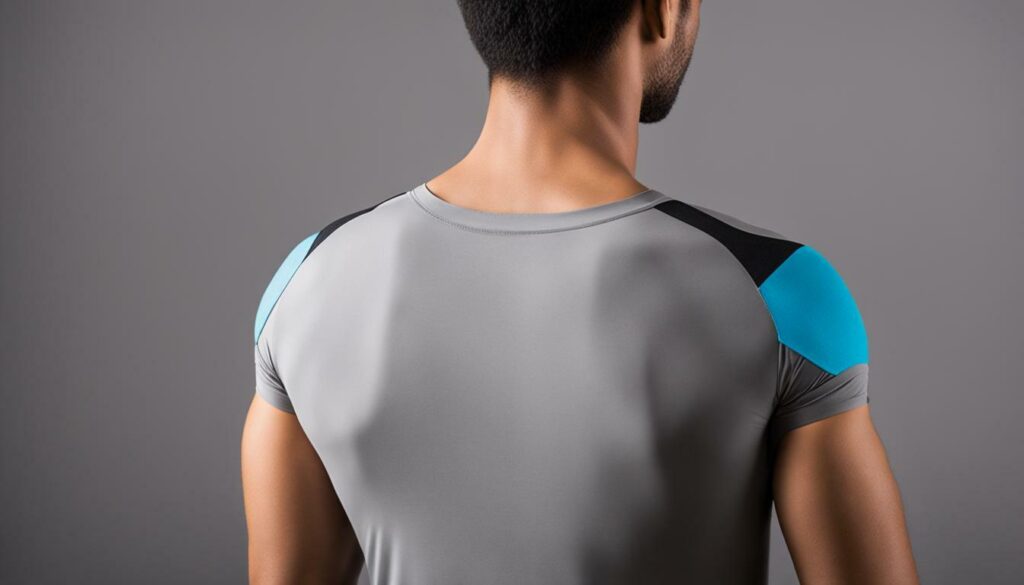Posture is an essential element of human movement that is often overlooked by many individuals. Poor posture can lead to shoulder, neck, and upper back pain, which can be improved with the use of kinesiology tape. In a case study, a sedentary worker with rounded shoulder posture experienced progressive improvement and complete relief of upper back pain with the use of kinesiology tape. Additionally, posture-improving exercises can be learned from experts in the field.
To apply kinesiology tape for postural support, follow these steps:
- Cut two long I-strips.
- Apply the anchor over the upper trapezius without tension.
- Remove the backing and place the patient’s shoulders in a slightly retracted position.
- Remove the backing to the end of the tape and apply the tape across the spine to the inferior border of the contralateral scapula with 25-50% tension.
- Apply the second anchor with no tension.
- Apply the second strip in the same manner on the other side, creating an “X” across the patient’s spine.
- Rub the kinesiology tape down onto the skin to ensure optimum adhesion.
Kinesiology tape can also be used to improve posture in the office and throughout the day. As we spend more time at computers, driving, and looking at our phones, we tend to slouch and develop rounded upper back posture. This can negatively impact our health and performance in the gym.
To assist with posture, a simple one-step method can be used. With the assistance of a friend, the athlete should sit or stand with a tall correct posture, slightly retracting the shoulder blades, keeping the head neutral, and maintaining a tall/long torso. Then, a piece of tape is measured to span from shoulder blade to shoulder blade, and the center adhesive is placed between the shoulder blades. The tape is stretched to create a 20-50% tension on each side and thoroughly rubbed in. This provides a sense of tension or pull on the shoulder blades, cueing the individual to sit up tall with correct posture.
Kinesiology tape can be applied in various ways to correct specific postural issues, such as rounded shoulders, forward head posture, or swayback. For rounded shoulders, two parallel strips of tape can be applied from the upper back to the front of the shoulders to gently remind the individual to retract the shoulder blades. For forward head posture, a “Y” shaped tape can be applied from the base of the neck to the shoulders, encouraging the chin to tuck in and the neck to lengthen. For swayback, a horizontal strip of tape can be applied around the lower back, cueing the individual to engage core muscles and maintain a neutral spine.
To achieve the best results with kinesiology tape for posture improvement, it is important to clean and dry the skin before application, trim the edges of the tape to reduce friction, apply the tape with no tension on the anchor end and stretch it to the desired tension on the other end, rub the tape gently to activate the adhesive, and avoid excessive stretching or wrinkling of the tape.
While kinesiology tape is generally safe, there are precautions to take when using it for posture correction. It should not be applied to broken or irritated skin, allergic reactions to the adhesive should be considered, and individuals with underlying medical conditions should seek professional advice. It should not be applied too tightly or for prolonged periods to avoid compromising circulation or causing skin irritation.
Key Takeaways:
- The kinesiology method is an effective method for improving posture.
- Kinesiology tape provides support, stability, and sensory feedback to the muscles and joints.
- Kinesiology tape can be applied in various ways to correct specific postural issues.
- Proper application techniques and necessary precautions should be followed for the best results with kinesiology tape for posture improvement.
The Power of Kinesiology Tape for Postural Support
Poor posture can lead to shoulder, neck, and upper back pain, which can be improved with the use of kinesiology tape. Kinesiology tape is a therapeutic tool that can facilitate muscle activation, enhance proprioception, and reduce pain and inflammation. It is made of flexible, elastic cotton with a wave-like acrylic adhesive that mimics the properties of the skin.
Kinesiology tape is effective because it can provide postural support without limiting range of motion or causing discomfort. It works by lifting the skin and creating space between the skin and the underlying muscles, allowing for better circulation and lymphatic drainage. It also stimulates the sensory receptors in the skin and muscles, providing feedback to the nervous system and promoting better movement patterns.
Kinesiology tape can be used for a variety of postural issues, such as rounded shoulders, forward head posture, and hyperlordosis. It can also be used to provide support for weak or injured muscles, such as the rotator cuff, the lower back muscles, and the quadriceps.
One of the key benefits of kinesiology tape is that it is easy to apply and can be done at home. To apply kinesiology tape for postural support, follow these steps:
- Cut two long I-strips.
- Apply the anchor over the upper trapezius without tension.
- Remove the backing and place the patient’s shoulders in a slightly retracted position.
- Remove the backing to the end of the tape and apply the tape across the spine to the inferior border of the contralateral scapula with 25-50% tension.
- Apply the second anchor with no tension.
- Apply the second strip in the same manner on the other side, creating an “X” across the patient’s spine.
- Rub the kinesiology tape down onto the skin to ensure optimum adhesion.
Kinesiology tape can also be used to improve posture in the office and throughout the day. As we spend more time at computers, driving, and looking at our phones, we tend to slouch and develop rounded upper back posture. This can negatively impact our health and performance in the gym.
To assist with posture, a simple one-step method can be used. With the assistance of a friend, the athlete should sit or stand with a tall correct posture, slightly retracting the shoulder blades, keeping the head neutral, and maintaining a tall/long torso. Then, a piece of tape is measured to span from shoulder blade to shoulder blade, and the center adhesive is placed between the shoulder blades. The tape is stretched to create a 20-50% tension on each side and thoroughly rubbed in. This provides a sense of tension or pull on the shoulder blades, cueing the individual to sit up tall with correct posture.
Kinesiology tape can be applied in various ways to correct specific postural issues, such as rounded shoulders, forward head posture, or swayback. For rounded shoulders, two parallel strips of tape can be applied from the upper back to the front of the shoulders to gently remind the individual to retract the shoulder blades. For forward head posture, a “Y” shaped tape can be applied from the base of the neck to the shoulders, encouraging the chin to tuck in and the neck to lengthen. For swayback, a horizontal strip of tape can be applied around the lower back, cueing the individual to engage core muscles and maintain a neutral spine.
To achieve the best results with kinesiology tape for posture improvement, it is important to clean and dry the skin before application, trim the edges of the tape to reduce friction, apply the tape with no tension on the anchor end and stretch it to the desired tension on the other end, rub the tape gently to activate the adhesive, and avoid excessive stretching or wrinkling of the tape.
While kinesiology tape is generally safe, there are precautions to take when using it for posture correction. It should not be applied to broken or irritated skin, allergic reactions to the adhesive should be considered, and individuals with underlying medical conditions should seek professional advice. It should not be applied too tightly or for prolonged periods to avoid compromising circulation or causing skin irritation.

Case Study: Kinesiology Tape for Upper Back Pain Relief
In a case study, a sedentary worker with rounded shoulder posture experienced progressive improvement and complete relief of upper back pain with the use of kinesiology tape. Kinesiology tape helped support the muscles around the upper back and shoulder area, promoting better alignment and reducing strain on the affected muscles.
Kinesiology tape can be a helpful addition to traditional treatment methods for upper back pain, such as physical therapy or chiropractic care. It provides a non-invasive and drug-free alternative for pain relief and can improve mobility and function in the affected area.
When using kinesiology tape for upper back pain relief, it is important to follow proper techniques for application and to consult with a medical professional if you have any underlying medical conditions or concerns.
The application of kinesiology tape for upper back pain relief involves placing an anchor over the upper trapezius without tension. The tape is then placed across the spine to the inferior border of the contralateral scapula with 25-50% tension. The tape is then secured with a second anchor with no tension.
Kinesiology tape can be a useful tool for improving posture and reducing pain in the upper back. By following proper application techniques and seeking professional advice when needed, individuals can experience the benefits of kinesiology tape for upper back pain relief.

Posture-Improving Exercises with Experts
Additionally, posture-improving exercises can be learned from experts in the field of kinesiology. These exercises aim to improve muscle strength, flexibility, and joint range of motion, promoting better posture and reducing the risk of pain or injury.
Common exercises for posture correction include scapular retractions, shoulder external rotations, thoracic extensions, and core stabilization exercises. These exercises target the muscles of the upper back, shoulder girdle, and core, helping to correct round shoulders, forward head posture, and swayback.
Scapular retractions involve squeezing the shoulder blades together, which helps to strengthen the muscles of the upper back, improving posture and reducing the risk of shoulder and neck pain. Shoulder external rotations target the rotator cuff muscles, which help to stabilize the shoulder joint and maintain proper upper body alignment. Thoracic extensions aim to increase mobility in the thoracic spine, promoting better posture and reducing the risk of lower back pain. Core stabilization exercises, such as planks or bird dogs, target the muscles of the trunk and pelvis, helping to maintain a neutral spine and reducing the risk of lower back pain.
These exercises should be performed regularly, with proper form and technique, and gradually progressed in intensity and duration. It is recommended to seek guidance from a qualified kinesiology expert or physical therapist, who can assess individual posture and provide personalized exercise programs.
By incorporating kinesiology exercises into your daily routine, along with the use of kinesiology tape, you can effectively improve your posture and reduce the risk of pain or injury. With proper application techniques and precautions, kinesiology tape can be a safe and effective tool for promoting better alignment and body mechanics.

Step-by-Step Guide: Applying Kinesiology Tape for Postural Support
Posture is an essential element of human movement that is often overlooked by many individuals. Poor posture can lead to shoulder, neck, and upper back pain, which can be improved with the use of kinesiology tape. In a case study, a sedentary worker with rounded shoulder posture experienced progressive improvement and complete relief of upper back pain with the use of kinesiology tape. Additionally, posture-improving exercises can be learned from experts in the field.
To apply kinesiology tape for postural support, follow these steps:
- Cut two long I-strips.
- Apply the anchor over the upper trapezius without tension.
- Remove the backing and place the patient’s shoulders in a slightly retracted position.
- Remove the backing to the end of the tape and apply the tape across the spine to the inferior border of the contralateral scapula with 25-50% tension.
- Apply the second anchor with no tension.
- Apply the second strip in the same manner on the other side, creating an “X” across the patient’s spine.
- Rub the kinesiology tape down onto the skin to ensure optimum adhesion.
Kinesiology tape can also be used to improve posture in the office and throughout the day. As we spend more time at computers, driving, and looking at our phones, we tend to slouch and develop rounded upper back posture. This can negatively impact our health and performance in the gym.
To assist with posture, a simple one-step method can be used. With the assistance of a friend, the athlete should sit or stand with a tall correct posture, slightly retracting the shoulder blades, keeping the head neutral, and maintaining a tall/long torso. Then, a piece of tape is measured to span from shoulder blade to shoulder blade, and the center adhesive is placed between the shoulder blades. The tape is stretched to create a 20-50% tension on each side and thoroughly rubbed in. This provides a sense of tension or pull on the shoulder blades, cueing the individual to sit up tall with correct posture.
Kinesiology tape can be applied in various ways to correct specific postural issues, such as rounded shoulders, forward head posture, or swayback. For rounded shoulders, two parallel strips of tape can be applied from the upper back to the front of the shoulders to gently remind the individual to retract the shoulder blades. For forward head posture, a “Y” shaped tape can be applied from the base of the neck to the shoulders, encouraging the chin to tuck in and the neck to lengthen. For swayback, a horizontal strip of tape can be applied around the lower back, cueing the individual to engage core muscles and maintain a neutral spine.
To achieve the best results with kinesiology tape for posture improvement, it is important to clean and dry the skin before application, trim the edges of the tape to reduce friction, apply the tape with no tension on the anchor end and stretch it to the desired tension on the other end, rub the tape gently to activate the adhesive, and avoid excessive stretching or wrinkling of the tape.
While kinesiology tape is generally safe, there are precautions to take when using it for posture correction. It should not be applied to broken or irritated skin, allergic reactions to the adhesive should be considered, and individuals with underlying medical conditions should seek professional advice. It should not be applied too tightly or for prolonged periods to avoid compromising circulation or causing skin irritation.
In conclusion, kinesiology taping is an effective and non-invasive method for improving posture. It provides support, stability, and sensory feedback to the muscles and joints, helping correct postural issues and promote better body alignment. By following proper application techniques and taking necessary precautions, individuals can experience the benefits of kinesiology tape for posture improvement.

Kinesiology Tape for Office Posture Improvement
Kinesiology tape can also be used to improve posture in the office and throughout the day. As we spend more time at computers, driving, and looking at our phones, we tend to slouch and develop rounded upper back posture. This can negatively impact our health and performance in the gym.
To assist with posture, a simple one-step method can be used. With the assistance of a friend, the athlete should sit or stand with a tall correct posture, slightly retracting the shoulder blades, keeping the head neutral, and maintaining a tall/long torso. Then, a piece of tape is measured to span from shoulder blade to shoulder blade, and the center adhesive is placed between the shoulder blades. The tape is stretched to create a 20-50% tension on each side and thoroughly rubbed in. This provides a sense of tension or pull on the shoulder blades, cueing the individual to sit up tall with correct posture.
When applying kinesiology tape in the office or throughout the day, it is important to keep in mind that the tape may not last as long due to movement and sweat. Therefore, it may be necessary to reapply the tape or try a different taping method to ensure proper support and improved posture.

Simple Method for Posture Assistance
To assist with posture, a simple one-step method can be used. With the assistance of a friend, the athlete should sit or stand with a tall correct posture, slightly retracting the shoulder blades, keeping the head neutral, and maintaining a tall/long torso. Then, a piece of tape is measured to span from shoulder blade to shoulder blade, and the center adhesive is placed between the shoulder blades. The tape is stretched to create a 20-50% tension on each side and thoroughly rubbed in. This provides a sense of tension or pull on the shoulder blades, cueing the individual to sit up tall with correct posture.
This technique is easy to use and can be applied throughout the day to promote better posture in the office or at home. It is also a great way to improve performance in the gym and prevent injuries related to poor posture. By using kinesiology tape for posture assistance, individuals can train their muscles and joints to maintain proper alignment and improve their overall health and wellness.

Specific Kinesiology Tape Applications for Postural Issues
Kinesiology tape can be applied in various ways to correct specific postural issues and improve body alignment. Here are some suggestions for addressing common postural problems:
- Rounded Shoulders: Apply two parallel strips of tape from the upper back to the front of the shoulders to gently remind the individual to retract the shoulder blades.
- Forward Head Posture: Apply a “Y” shaped tape from the base of the neck to the shoulders to encourage the chin to tuck in and the neck to lengthen.
- Swayback: Apply a horizontal strip of tape around the lower back to cue the individual to engage core muscles and maintain a neutral spine.
By using kinesiology tape to address specific postural issues, individuals can experience improved muscle activation, reduced pain, and increased mobility. It is important to apply the tape correctly and seek professional advice if necessary.

Tips for Best Results with Kinesiology Tape for Posture Improvement
To achieve the best results with kinesiology tape for posture improvement, it is important to follow these tips:
- Clean and dry the skin before application. This ensures proper adhesion and longevity of the tape.
- Trim the edges of the tape to reduce friction and irritation to the skin.
- Apply the tape with no tension on the anchor end and stretch it to the desired tension on the other end. This ensures proper support and feedback to the muscles.
- Rub the tape gently to activate the adhesive. This enhances the adhesion and reduces the risk of the tape peeling off.
- Avoid excessive stretching or wrinkling of the tape. This can compromise its effectiveness and cause discomfort.
By following these tips, individuals can optimize the benefits of kinesiology tape for posture improvement.

“Kinesiology taping is an effective and non-invasive method for improving posture. It provides support, stability, and sensory feedback to the muscles and joints, helping correct postural issues and promote better body alignment.”
Precautions when Using Kinesiology Tape for Posture Correction
While kinesiology tape is generally safe, there are precautions to take when using it for posture correction. Firstly, it is recommended to clean and dry the skin before applying the tape to avoid irritation. Individuals with sensitive skin should test the tape on a small area first to check for allergic reactions. If any irritation occurs, remove the tape immediately and discontinue use.
Kinesiology tape should not be applied to broken or irritated skin, as this can cause further damage. It should not be applied too tightly or for prolonged periods to avoid compromising circulation or causing skin irritation. It is important to trim the edges of the tape to reduce friction and avoid excessive stretching or wrinkling of the tape, which can reduce its effectiveness.
Individuals with underlying medical conditions, such as circulatory disorders or skin diseases, should seek professional advice before using kinesiology tape. Pregnant women should also consult their doctor before use.
By taking these precautions, individuals can safely use kinesiology tape for posture correction and experience the benefits of improved posture and reduced pain.
The Benefits of Kinesiology Taping for Posture Improvement
Posture is an essential element of human movement that is often overlooked by many individuals. Poor posture can lead to shoulder, neck, and upper back pain, which can be improved with the use of kinesiology tape. In a case study, a sedentary worker with rounded shoulder posture experienced progressive improvement and complete relief of upper back pain with the use of kinesiology tape. Additionally, posture-improving exercises can be learned from experts in the field.
To apply kinesiology tape for postural support, follow these steps:
- Cut two long I-strips.
- Apply the anchor over the upper trapezius without tension.
- Remove the backing and place the patient’s shoulders in a slightly retracted position.
- Remove the backing to the end of the tape and apply the tape across the spine to the inferior border of the contralateral scapula with 25-50% tension.
- Apply the second anchor with no tension.
- Apply the second strip in the same manner on the other side, creating an “X” across the patient’s spine.
- Rub the kinesiology tape down onto the skin to ensure optimum adhesion.
Kinesiology tape can also be used to improve posture in the office and throughout the day. As we spend more time at computers, driving, and looking at our phones, we tend to slouch and develop rounded upper back posture. This can negatively impact our health and performance in the gym.
To assist with posture, a simple one-step method can be used. With the assistance of a friend, the athlete should sit or stand with a tall correct posture, slightly retracting the shoulder blades, keeping the head neutral, and maintaining a tall/long torso. Then, a piece of tape is measured to span from shoulder blade to shoulder blade, and the center adhesive is placed between the shoulder blades. The tape is stretched to create a 20-50% tension on each side and thoroughly rubbed in. This provides a sense of tension or pull on the shoulder blades, cueing the individual to sit up tall with correct posture.
Kinesiology tape can be applied in various ways to correct specific postural issues, such as rounded shoulders, forward head posture, or swayback. For rounded shoulders, two parallel strips of tape can be applied from the upper back to the front of the shoulders to gently remind the individual to retract the shoulder blades. For forward head posture, a “Y” shaped tape can be applied from the base of the neck to the shoulders, encouraging the chin to tuck in and the neck to lengthen. For swayback, a horizontal strip of tape can be applied around the lower back, cueing the individual to engage core muscles and maintain a neutral spine.
To achieve the best results with kinesiology tape for posture improvement, it is important to clean and dry the skin before application, trim the edges of the tape to reduce friction, apply the tape with no tension on the anchor end and stretch it to the desired tension on the other end, rub the tape gently to activate the adhesive, and avoid excessive stretching or wrinkling of the tape.
While kinesiology tape is generally safe, there are precautions to take when using it for posture correction. It should not be applied to broken or irritated skin, allergic reactions to the adhesive should be considered, and individuals with underlying medical conditions should seek professional advice. It should not be applied too tightly or for prolonged periods to avoid compromising circulation or causing skin irritation.
In conclusion, kinesiology taping is an effective and non-invasive method for improving posture. It provides support, stability, and sensory feedback to the muscles and joints, helping correct postural issues and promote better body alignment. By following proper application techniques and taking necessary precautions, individuals can experience the benefits of kinesiology tape for posture improvement.

Conclusion
By following proper application techniques and taking necessary precautions, individuals can experience the benefits of kinesiology tape for posture improvement. Kinesiology tape provides support, stability, and sensory feedback to the muscles and joints, helping correct postural issues and promote better body alignment.
Learning posture-improving exercises from experts in the field and using simple methods for posture assistance can also significantly improve posture. Kinesiology tape can be applied in various ways to correct specific postural issues, such as rounded shoulders, forward head posture, or swayback. It can also be used to improve posture in the office and throughout the day.
To achieve the best results with kinesiology tape for posture improvement, it is important to follow the proper techniques, clean and dry the skin before application, trim the edges of the tape, and avoid excessive stretching or wrinkling of the tape. Precautions should also be taken to ensure safe and effective use of kinesiology tape for posture correction.
Overall, kinesiology taping is an effective and non-invasive method for improving posture. By incorporating this technique into their daily routine, individuals can enhance their physical performance, reduce pain, and improve their overall quality of life.
FAQ
Q: How does kinesiology tape help improve posture?
A: Kinesiology tape provides support, stability, and sensory feedback to the muscles and joints, helping correct postural issues and promote better body alignment.
Q: Can kinesiology tape relieve upper back pain?
A: Yes, kinesiology tape has been shown to provide relief of upper back pain, as demonstrated in a case study.
Q: How can I learn posture-improving exercises?
A: You can learn posture-improving exercises from experts in the field who specialize in kinesiology.
Q: What are the steps for applying kinesiology tape for postural support?
A: Cut two long I-strips, apply the anchor over the upper trapezius, place the patient’s shoulders in a slightly retracted position, apply the tape across the spine with tension, apply the second anchor, and create an “X” with the second strip across the spine.
Q: How can kinesiology tape be used to improve office posture?
A: Kinesiology tape can be applied to cue proper posture in the office by measuring a piece of tape from shoulder blade to shoulder blade and placing it between the shoulder blades with tension.
Q: What specific postural issues can kinesiology tape correct?
A: Kinesiology tape can correct rounded shoulders with parallel strips, forward head posture with a “Y” shaped tape, and swayback with a horizontal strip around the lower back.
Q: What are some tips for achieving the best results with kinesiology tape for posture improvement?
A: Clean and dry the skin, trim the edges of the tape, apply with no tension on the anchor end, stretch to desired tension on the other end, rub gently to activate adhesive, and avoid excessive stretching or wrinkling of the tape.
Q: What precautions should I take when using kinesiology tape for posture correction?
A: Avoid applying to broken or irritated skin, consider potential allergic reactions to the adhesive, and seek professional advice if you have underlying medical conditions. Avoid applying too tightly or for prolonged periods to prevent circulation issues or skin irritation.
Q: What are the benefits of using kinesiology tape for posture improvement?
A: Kinesiology taping provides support, stability, and sensory feedback to improve body alignment and correct postural issues.




